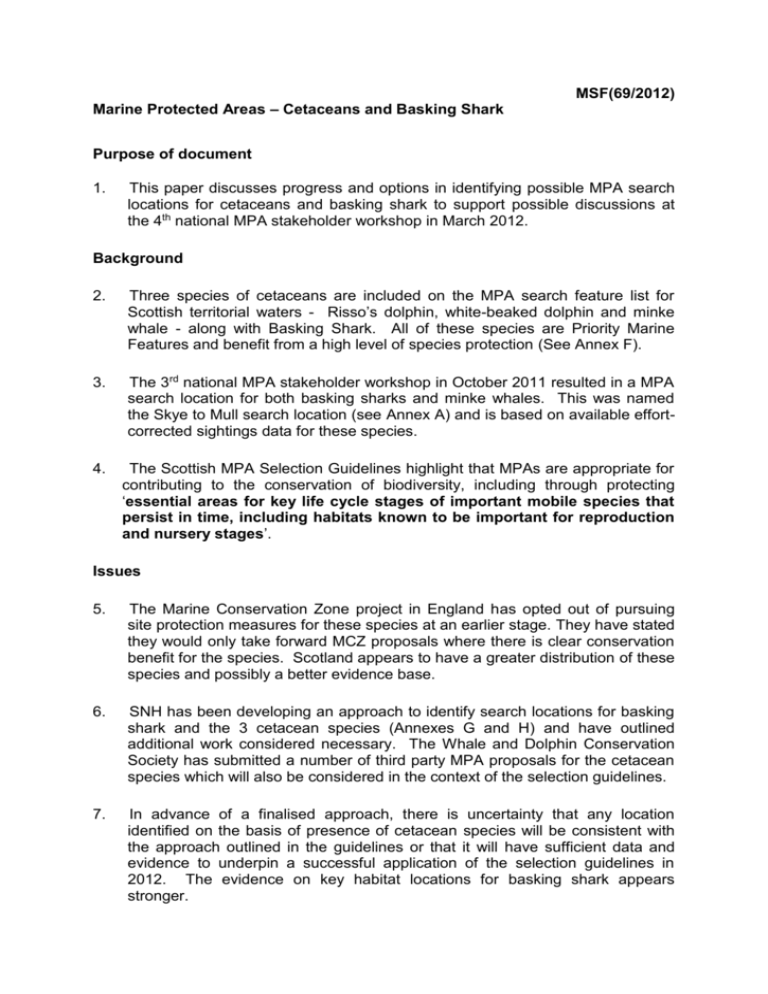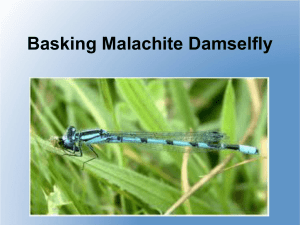Marine Protected Areas – Cetaceans and Basking Shark
advertisement

MSF(69/2012) Marine Protected Areas – Cetaceans and Basking Shark Purpose of document 1. This paper discusses progress and options in identifying possible MPA search locations for cetaceans and basking shark to support possible discussions at the 4th national MPA stakeholder workshop in March 2012. Background 2. Three species of cetaceans are included on the MPA search feature list for Scottish territorial waters - Risso’s dolphin, white-beaked dolphin and minke whale - along with Basking Shark. All of these species are Priority Marine Features and benefit from a high level of species protection (See Annex F). 3. The 3rd national MPA stakeholder workshop in October 2011 resulted in a MPA search location for both basking sharks and minke whales. This was named the Skye to Mull search location (see Annex A) and is based on available effortcorrected sightings data for these species. 4. The Scottish MPA Selection Guidelines highlight that MPAs are appropriate for contributing to the conservation of biodiversity, including through protecting ‘essential areas for key life cycle stages of important mobile species that persist in time, including habitats known to be important for reproduction and nursery stages’. Issues 5. The Marine Conservation Zone project in England has opted out of pursuing site protection measures for these species at an earlier stage. They have stated they would only take forward MCZ proposals where there is clear conservation benefit for the species. Scotland appears to have a greater distribution of these species and possibly a better evidence base. 6. SNH has been developing an approach to identify search locations for basking shark and the 3 cetacean species (Annexes G and H) and have outlined additional work considered necessary. The Whale and Dolphin Conservation Society has submitted a number of third party MPA proposals for the cetacean species which will also be considered in the context of the selection guidelines. 7. In advance of a finalised approach, there is uncertainty that any location identified on the basis of presence of cetacean species will be consistent with the approach outlined in the guidelines or that it will have sufficient data and evidence to underpin a successful application of the selection guidelines in 2012. The evidence on key habitat locations for basking shark appears stronger. Options for Way Forward 8. There are 3 options for the way forward; 1. Identify search locations on the basis on the draft SNH approach for discussion at workshop 4, recognising that reliance on effort corrected sightings data may be necessary. 2. Recognise that the detailed approach has not yet been finalised (and that it may be challenging to identify search locations for key life cycle stages for these mobile species based on sightings data) and instead discuss the possible approach at workshop 4, including critical habitat criteria (Annex H) and what we know about the presence of these species. Then complete the data gathering, modelling, and evidence building to identify search locations and subsequently applying the guidelines. This may mean these species could be gaps in the MPA network at the end of 2012. 3. In light of their protected species status allow our knowledge of temporal and spatial presence to be accounted for via the Priority Marine Features list and the marine planning system, instead of proceeding at this stage with the identification of possible search locations and ultimately possible MPAs. This would complement existing species protection and give provisions under 2 of the 3 pillars of the marine conservation strategy. Recommendations 1. That you note the current issues relating to these mobile species and information contained in the annexes. 2. Offer your views on which option at paragraph 8 is the most suitable way forward for these species, noting that basking shark evidence is better at this stage. 3. Offer views on how the existing Skye to Mull search location and the third party proposals should be handled in light of your views on point 2. 4. Offer views on the draft critical habitat criteria in the table at Annex H in terms of the proposed approach outlined in the MPA guidelines. ANNEXES A. Map of the existing Skye to Mull mobile species search location B. Risso’s Dolphin distribution C. White-beaked dolphin distribution D. Minke Whale distribution E. Basking shark distribution F. Existing mobile species protection G. Possible role of MPAs for mobile species H. Possible criteria for identifying critical Annex A - Initial MPA search locations identified for minke whale showing revised Skye to Mull search location following discussion at workshop 3. ANNEX B – RISSO’S DOLPHIN Figure 2: Distribution of Risso’s dolphins in north-west Europe (Reid et al., 2003) Scottish waters are a stronghold for Risso’s dolphin in a UK context. They are most common to the west of Scotland from the west coast to the edge of the continental shelf but also recorded from the outer Moray Firth, the Aberdeenshire coast and the Shetland Islands. In the North-East Atlantic the Shetland Islands are considered to be the northerly limit of their distribution. Whilst this species is generally considered to be a shelf-edge and deep-water species, around the UK it appears to be most abundant in shelf waters. In terms of seasonal distribution, Risso’s dolphins are present throughout the year with peaks in relative abundance/sightings between June and September. In early summer, they are more likely to be found in deeper waters further from the coast, whilst later on they are more likely to be found in coastal waters. There are no population estimates for the North-East Atlantic, UK or Scotland. ANNEX C –WHITE BEAKED DOLPHIN Figure 3: Distribution of white-beaked dolphins in north-west Europe (Reid et al., 2003) White-beaked dolphins are distributed widely throughout Scottish shelf waters and Scottish waters are considered the main stronghold for white-beaked dolphins in both the UK and Europe. There are two main areas where white-beaked dolphin abundance is relatively higher: in the western North Sea, particularly off the Aberdeenshire coast and off the west coast in The Minch and to the north and west of Lewis. Seasonal distribution seems to vary between the west and east coast with the former being used year round and the latter predominantly being used between June and October. There is some evidence of a contracting range, with possibly a more northerly distribution on the west coast linked to climate change, specifically to changes in water temperature. Population estimates indicate ~22,700 white-beaked dolphins in the North Sea and European Atlantic continental shelf waters from SCANS II in 2005. ANNEX D – MINKE WHALE Figure 4: Distribution of common minke whales in north-west Europe (Reid et al., 2003) Minke whales are widely distributed throughout Scottish shelf waters. There are two broad swathes of relatively high abundance which occur down the east coast from the outer Moray Firth south to England and off the west coast of Scotland in The Minch, The Little Minch and the Sea of the Hebrides. The relative abundance of minke whales within these two broad areas appears to be higher than elsewhere in the UK or North-west Europe. Minke whales are largely seen between May and September. The presence of minke whales in Scottish shelf waters during the summer months is representative of their occurrence on high-latitude feeding grounds and represents a critical stage in their lifecycle since animals have to build up sufficient energy reserves (stored as blubber) during the feeding season to enable them to migrate to winter breeding grounds. The 1994 SCANS survey estimated a total of ~8,500 minke whales in the North Sea, Celtic Sea and Skagerrak but this area did not include most of the west coast of Scotland. The 2005 SCANS survey estimated a total of ~18,600 minke whales in the North Sea and European Atlantic continental shelf waters. ANNEX E – BASKING SHARK Figure 2: Basking shark distribution (from FAO website) Basking sharks are found globally in both the Pacific and Atlantic oceans, predominantly in coastal waters and over the continental shelf of temperate waters (Compagno, 2001). Around the UK, basking sharks are sighted all around the coast but predominantly around the south west peninsula of England and around the west coast of Scotland (MCS website; Bloomfield and Soldant, 2007). Annex F – Existing mobile species protection 1. In 2011 Marine Scotland published its marine nature conservation strategy. This document sets out a three pillar approach to marine nature conservation comprising: protected species, protected sites and wider seas policies and measures. 2. The main mechanism providing protection to cetaceans comes from their listing as European Protected Species (EPS). All species of cetaceans are listed as EPS under Annex IV of the EC Habitats Directive. This means it is an offence to deliberately or recklessly: a. b. c. d. e. f. g. h. Capture, injure or kill any wild animal of a European protected species. Harass such an animal or group of animals. Disturb such an animal while it is rearing or otherwise caring for its young. Obstruct access to a breeding site or resting place, or otherwise deny the animal use of the breeding site or resting place. Disturb such an animal while it is occupying a structure or place used for shelter or protection. Disturb such an animal in a manner that is, or in circumstances which are, likely to significantly affect the local distribution or abundance of the species to which it belongs. Disturb such an animal in a manner that is, or in circumstances which are, likely to impair its ability to survive, breed or reproduce, or rear or otherwise care for its young. Take or destroy the eggs of such an animal. 3. In addition to the protection afforded to all EPS, it is an offence to deliberately or recklessly disturb any dolphin, porpoise or whale. 4. Basking sharks are listed on Schedule 5 of the Wildlife and Countryside Act 1981 (as amended) and as such are protected against killing, taking or injuring as well as the intentional or reckless disturbance or harassment in territorial waters. European Council Regulation 2555/2001 also provides protection with a zero total allowable catch in European waters. Furthermore basking sharks are also listed as vulnerable worldwide and endangered in north- east Atlantic (International Union for Conservation Nature 2004 Red list). Annex G - Possible Role of MPAs for mobile species 1. The Scottish MPA Selection Guidelines highlight that MPAs are appropriate for contributing to the conservation of biodiversity, including through protecting ‘essential areas for key life cycle stages of important mobile species that persist in time, including habitats known to be important for reproduction and nursery stages’. 2. MPAs are a tool designed to provide spatial habitat protection. In order to consider the appropriateness of MPAs for these species you first have identify types of habitats that might be critical to cetaceans and basking sharks. A draft Scottish Natural Heritage report identifies a number of different types of habitats that could be described as critical habitats for mobile species. 3. The draft report goes on to recommend a subset that could provide a focus for the identification of MPA search locations. (i) (ii) (iii) (iv) (v) (vi) (vii) places used regularly for feeding, breeding, calving/spawning and/or raising young and socialising; locations where associated and supporting activities (e.g. courtship, resting, playing, communication) take place; (additional) locations with (regular) seasonal concentrations; movement corridors, including migration routes and resting areas, connecting important areas (such as the above); static areas/(benthic) habitats of critical importance to (preferred) prey (e.g. sandeels require specific sand/gravel bed habitats and bottom current speeds); areas where important ecosystem processes occur that support high (primary) productivity of (pelagic) prey species (e.g. thermal fronts); areas where there are topographic structures that enhance productivity and/or foraging opportunities (e.g. sub-surface hotspots of primary productivity generated by internal wave mixing over bumpy topography such as banks or troughs (Scott et al, 2008); tidal races generated by surrounding topography. It would be helpful for the Marine Strategy Forum to comment on whether these criteria, as per the species assessment at Annex H would be deliver on the statement in bold above at paragraph 1. ANNEX H – Possible criteria for mobile species critical habitats Possible Identifier Places used regularly for feeding, breeding, calving/spawning and/or raising young and socialising. Risso’s Dolphin Consider locations where adults are regular seen with calves as potential critical habitat. White-beaked Dolphin Consider locations where adults are regular seen with calves as potential critical habitat. Minke Whale N/a Basking Shark Consider locations where aggregations occur, high level of surface feeding, functional links to zooplankton Locations with (regular) seasonal concentrations. Consistent presence (whether or not it is seasonal) should be the minimum requirement for identification of MPA search locations. Movement corridors, including migration routes and resting areas, connecting important areas. Areas containing habitats of critical importance to prey Evidence very limited and so not recommended as potential critical habitat. Consistent presence (whether or not is seasonal) should be the minimum requirement for identification of MPA search locations. N/a Consistent presence (whether or not is seasonal) should be the minimum requirement for identification of MPA search locations. N/a Consistent presence (whether or not is seasonal) should be the minimum requirement for identification of MPA search locations. N/a Not considered as potential critical habitat relevant to MPAs because prey species are highly mobile. Not considered as potential critical habitat because of variability in formation of front location. . N/a Consider habitats of sandeels, sprat (and herring?) as potential critical habitat. tbc N/a Associated with slope habitats. Consider areas of slope habitat as potential critical habitat. Consider areas with shelf banks and mounds and shelf deeps as potential critical habitat. Areas where important ecosystem processes occur that support high productivity of prey species (e.g. thermal fronts). Areas where there are topographic structures that enhance productivity and/or foraging opportunities Consider locations where surface thermal fronts are predictable and persistent as potential critical habitat. Consider areas with shelf banks and mounds and shelf deeps as potential critical habitat. Fronts of mixed water supporting high productivity of prey zooplankton Calanus sp linked to basking shark feeding behaviour tbc







